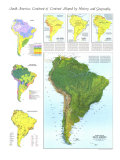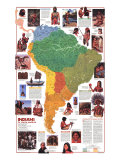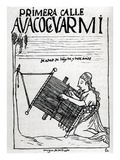* Lesson plan idea - have your students update the information and latest statistics concerning the indigineous populations in the Americas; discuss the political, economic, and environmental situations that are current for the region. • maps
ARCHAEOLOGY OF SOUTH AMERICA
THE FERTILE HIGHLAND basins and coastal valleys of the central Andes became the seedbeds of South America's greatest pre-Columbian civilizations. The highly developed Incas represented the culmination of humanity's 20,000-year presence on the continent.
Traces of community life exist elsewhere – from the river valleys of the Amazon basin to caves as far south as Tierra del Fuego. But none of these was part of a progression leading to a sustained high culture. What was lacking was the fertile soil and population density associated with a long agricultural tradition. In the Andes such a tradition permitted the development of political organization, art, and great public works.
Even in the central Andes, however, the most renowned cultures took thousands of years to develop. From the distance of history, this spine of a continent resembles a dark screen on which pinpoints of light blink on and off, briefly illuminating cultural achievements in the scattered valleys and plateaus. These flashes reveal such imposing works of architecture as stone temples in the highlands and adobe pyramids along the coast.
Then, about 3,500 years ago, the light becme more constant. Expanding communities began making more and more contact with each other, chiefly through trade and the growth of cults. Archaeologist use the term “florescence” for these periods of rapid cultural development. One remarkable example sprang from the highlands of northern Peru at Chavin de Huantar. From there spread a shamanistic cult accompanied by advances in textiles, architecture, and pottery. A string of sites along the Peruvian coast represents even earlier exmples. At Huaca de los Reyes, 300 miles north of Lima, mud-plaster friezes bear human heads with feline cult centered at Chavin de Huantar.
The Andean cultural area exhibits the most impressive works of collective labor: huge irrigation systems that connected valleys; “highways of the sun” that linked widespread settlements; and the city of Cuzco, capital of the Inca Empire.
The study and documentation of pre-Columbian sites continues across the continent. It will take time, for archaeology is a much younger enterprise than plunder. Only in the past hundred years has the knowledge inherent in a flint tool or the ashes of an ancient fire motivated the kind of intensive search once reserved for precious metals and gems.
WORLD OF THE INCAS
INCA GRANDEUR had for its foundation more than 4,000 years of Andean cultural traditions. What distinguished the Incas from prior societies was the scope of their ambition, a more effective administration of their social structure, and the ability to enforce their will through battle. As the Inca Empire spread, the mere mention of their name was fearsome enough to cow some rivals into surrender.
Inca society was based on the mita – taxation in the form of labor – and on a three-way division of land. The fruits and products of one part were dedicate to the gods and the clergy; those of a second part were consigned tot the government; those of the third part went directly to the common people. This system that so successfully served the empire came to an end when Emperor Atahuallpa was capture, baptized, and then strangled by the Spaniards.
GROWTH OF THE INCA EMPIRE - With the rise of the first emperor, Pachacuti, the Inca Empire became known as Tahuantinsuyu, the “four quarters of the world.” Roads to the quarters – Chinchaysuyu, Condesuyu, Antisuyu, Collasuyu – radiated from Cuzco, the capital.
PUMA-SHAPED CUZCO - CROSSROADS of the Inca world, Cuzco was the seat of both secular and religious authority. This power is reflected in the city's design in th shape of a puma, with the monumental fortress of Sacsahuaman corresponding to the creature's head. At the heart lie Haucaypata and Cusipata, together known as the Great Plaza, where sacred ceremonies, including human sacrifices, were performed. The Spanish, who tore down and rebuilt much of Cuzco, never found the citadel of Machu Picchu, where imposing temples, graves, and residences were not discovered until 1911.
THE PROGRESSION OF CULTURES IN POTTERY
Durable and plentiful, pottery is a prime tracer in the archaeological search for links in the growth and diffusion of cultures. Certain recurrent themes may indicate the persistence of an artistic tradition even more ancient than local knowledge of pottery itself. For example, feline motifs in the Vicus and Lima styles seem prefigured by a gourd carved as much as 3,000 years earlier.
The widespread appearance of mythological beasts and men on pottery illustrates diffusion of shamanistic cults that drew scattered societies into a common religious bond. The deer head of a Moche shaman depicts swiftness in eluding demons. A pot from the same culture but a different site bears a macabre dance scene below an underworld ceremony.
ATTEMPTS TO LOCATE the origins and trace the development of pre-Columbian cultures in South America contend with a central difficulty; none had a written language or calendar. Although early European chroniclers recorded useful oral histories, archaeologists reconstruct the past by inferences drawn from patient excavation, examination, and comparison.
Dates for artifacts on this map were determined chiefly by the radioccarbon method and reflect recent corrections. One culture's influence on others can also be measured by such means as tracing styles of pottery, statuary, and weaving.
... The rise, spread, and fall of societies was seldom an even, measured process, and the greatest of them was the most abrupt. The Incas were a small, unremarkable group until their explosion across Peru and beyond as the Inca Enpire. Their end came at the hands of Francisco Pizarro and his conquistadores, and the the Inca Empire was effectively destroyed with the capture of Emperor Atahuallpa and the slaughter of his army, Saturday, November 16, 1532, just at sunset.



















